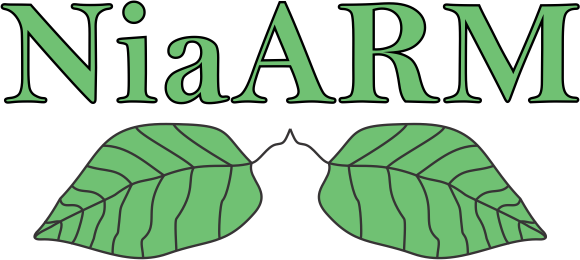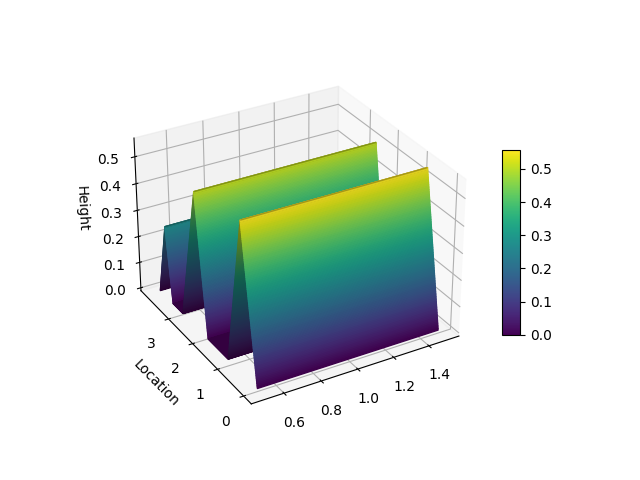A minimalistic framework for numerical association rule mining
Project description

NiaARM - A minimalistic framework for Numerical Association Rule Mining
NiaARM is a framework for Association Rule Mining based on nature-inspired algorithms for optimization. The framework is written fully in Python and runs on all platforms. NiaARM allows users to preprocess the data in a transaction database automatically, to search for association rules and provide a pretty output of the rules found. This framework also supports integral and real-valued types of attributes besides the categorical ones. Mining the association rules is defined as an optimization problem, and solved using the nature-inspired algorithms that come from the related framework called NiaPy.
- Documentation: https://niaarm.readthedocs.io/en/latest/
- Tested OS: Windows, Ubuntu, Fedora, Alpine, Arch, macOS. However, that does not mean it does not work on others
Detailed insights
The current version includes (but is not limited to) the following functions:
- loading datasets in CSV format,
- preprocessing of data,
- searching for association rules,
- providing output of mined association rules,
- generating statistics about mined association rules,
- visualization of association rules,
- association rule text mining (experimental).
Installation
pip
Install NiaARM with pip:
pip install niaarm
To install NiaARM on Alpine Linux, please enable Community repository and use:
$ apk add py3-niaarm
To install NiaARM on Arch Linux, please use an AUR helper:
$ yay -Syyu python-niaarm
To install NiaARM on Fedora, use:
$ dnf install python3-niaarm
Usage
Loading data
In NiaARM, data loading is done via the Dataset class. There are two options for loading data:
Option 1: From a pandas DataFrame (recommended)
import pandas as pd
from niaarm import Dataset
df = pd.read_csv('datasets/Abalone.csv')
# preprocess data...
data = Dataset(df)
print(data) # printing the dataset will generate a feature report
Option 2: From CSV file directly
from niaarm import Dataset
data = Dataset('datasets/Abalone.csv')
print(data)
Mining association rules the easy way (recommended)
Association rule mining can be easily performed using the get_rules function:
from niaarm import get_rules
from niapy.algorithms.basic import DifferentialEvolution
algo = DifferentialEvolution(population_size=50, differential_weight=0.5, crossover_probability=0.9)
metrics = ('support', 'confidence')
rules, run_time = get_rules(data, algo, metrics, max_iters=30, logging=True)
print(rules) # Prints basic stats about the mined rules
print(f'Run Time: {run_time}')
rules.to_csv('output.csv')
Mining association rules the hard way
The above example can be also be implemented using a more low level interface,
with the NiaARM class directly:
from niaarm import NiaARM, Dataset
from niapy.algorithms.basic import DifferentialEvolution
from niapy.task import Task, OptimizationType
# Create a problem:::
# dimension represents the dimension of the problem;
# features represent the list of features, while transactions depicts the list of transactions
# metrics is a sequence of metrics to be taken into account when computing the fitness;
# you can also pass in a dict of the shape {'metric_name': <weight of metric in range [0, 1]>};
# when passing a sequence, the weights default to 1.
problem = NiaARM(data.dimension, data.features, data.transactions, metrics=('support', 'confidence'), logging=True)
# build niapy task
task = Task(problem=problem, max_iters=30, optimization_type=OptimizationType.MAXIMIZATION)
# use Differential Evolution (DE) algorithm from the NiaPy library
# see full list of available algorithms: https://github.com/NiaOrg/NiaPy/blob/master/Algorithms.md
algo = DifferentialEvolution(population_size=50, differential_weight=0.5, crossover_probability=0.9)
# run algorithm
best = algo.run(task=task)
# sort rules
problem.rules.sort()
# export all rules to csv
problem.rules.to_csv('output.csv')
Visualization
The framework currently supports the hill slopes visualization method presented in [4]. More visualization methods are planned to be implemented in future releases.
from matplotlib import pyplot as plt
from niaarm import Dataset, RuleList, get_rules
from niaarm.visualize import hill_slopes
dataset = Dataset('datasets/Abalone.csv')
metrics = ('support', 'confidence')
rules, _ = get_rules(dataset, 'DifferentialEvolution', metrics, max_evals=1000, seed=1234)
some_rule = rules[150]
hill_slopes(some_rule, dataset.transactions)
plt.show()

Text Mining (Experimental)
An experimental implementation of association rule text mining using nature-inspired algorithms, based on ideas from [5]
is also provided. The niaarm.text module contains the Corpus and Document classes for loading and preprocessing corpora,
a TextRule class, representing a text rule, and the NiaARTM class, implementing association rule text mining
as a continuous optimization problem. The get_text_rules function, equivalent to get_rules, but for text mining, was also
added to the niaarm.mine module.
import pandas as pd
from niaarm.text import Corpus
from niaarm.mine import get_text_rules
from niapy.algorithms.basic import ParticleSwarmOptimization
df = pd.read_json('datasets/text/artm_test_dataset.json', orient='records')
documents = df['text'].tolist()
corpus = Corpus.from_list(documents)
algorithm = ParticleSwarmOptimization(population_size=200, seed=123)
metrics = ('support', 'confidence', 'aws')
rules, time = get_text_rules(corpus, max_terms=5, algorithm=algorithm, metrics=metrics, max_evals=10000, logging=True)
if len(rules):
print(rules)
print(f'Run time: {time:.2f}s')
rules.to_csv('output.csv')
else:
print('No rules generated')
print(f'Run time: {time:.2f}s')
Note: You may need to download stopwords and the punkt tokenizer from nltk by running import nltk; nltk.download('stopwords'); nltk.download('punkt').
For a full list of examples see the examples folder in the GitHub repository.
Command line interface
We provide a simple command line interface, which allows you to easily mine association rules on any input dataset, output them to a csv file and/or perform a simple statistical analysis on them.
niaarm -h
usage: niaarm [-h] [-v] -i INPUT_FILE [-o OUTPUT_FILE] -a ALGORITHM [-s SEED]
[--max-evals MAX_EVALS] [--max-iters MAX_ITERS] --metrics
METRICS [METRICS ...] [--weights WEIGHTS [WEIGHTS ...]] [--log]
[--show-stats]
Perform ARM, output mined rules as csv, get mined rules' statistics
options:
-h, --help show this help message and exit
-v, --version show program's version number and exit
-i INPUT_FILE, --input-file INPUT_FILE
Input file containing a csv dataset
-o OUTPUT_FILE, --output-file OUTPUT_FILE
Output file for mined rules
-a ALGORITHM, --algorithm ALGORITHM
Algorithm to use (niapy class name, e.g.
DifferentialEvolution)
-s SEED, --seed SEED Seed for the algorithm's random number generator
--max-evals MAX_EVALS
Maximum number of fitness function evaluations
--max-iters MAX_ITERS
Maximum number of iterations
--metrics METRICS [METRICS ...]
Metrics to use in the fitness function.
--weights WEIGHTS [WEIGHTS ...]
Weights in range [0, 1] corresponding to --metrics
--log Enable logging of fitness improvements
--show-stats Display stats about mined rules
Note: The CLI script can also run as a python module (python -m niaarm ...)
Reference Papers:
Ideas are based on the following research papers:
[1] I. Fister Jr., A. Iglesias, A. Gálvez, J. Del Ser, E. Osaba, I Fister. Differential evolution for association rule mining using categorical and numerical attributes In: Intelligent data engineering and automated learning - IDEAL 2018, pp. 79-88, 2018.
[2] I. Fister Jr., V. Podgorelec, I. Fister. Improved Nature-Inspired Algorithms for Numeric Association Rule Mining. In: Vasant P., Zelinka I., Weber GW. (eds) Intelligent Computing and Optimization. ICO 2020. Advances in Intelligent Systems and Computing, vol 1324. Springer, Cham.
[3] I. Fister Jr., I. Fister A brief overview of swarm intelligence-based algorithms for numerical association rule mining. arXiv preprint arXiv:2010.15524 (2020).
[4] Fister, I. et al. (2020). Visualization of Numerical Association Rules by Hill Slopes. In: Analide, C., Novais, P., Camacho, D., Yin, H. (eds) Intelligent Data Engineering and Automated Learning – IDEAL 2020. IDEAL 2020. Lecture Notes in Computer Science(), vol 12489. Springer, Cham. https://doi.org/10.1007/978-3-030-62362-3_10
[5] I. Fister, S. Deb, I. Fister, Population-based metaheuristics for Association Rule Text Mining, In: Proceedings of the 2020 4th International Conference on Intelligent Systems, Metaheuristics & Swarm Intelligence, New York, NY, USA, mar. 2020, pp. 19–23. doi: 10.1145/3396474.3396493.
License
This package is distributed under the MIT License. This license can be found online at http://www.opensource.org/licenses/MIT.
Disclaimer
This framework is provided as-is, and there are no guarantees that it fits your purposes or that it is bug-free. Use it at your own risk!
Project details
Release history Release notifications | RSS feed
Download files
Download the file for your platform. If you're not sure which to choose, learn more about installing packages.
Source Distribution
Built Distribution
File details
Details for the file niaarm-0.2.1.tar.gz.
File metadata
- Download URL: niaarm-0.2.1.tar.gz
- Upload date:
- Size: 25.4 kB
- Tags: Source
- Uploaded using Trusted Publishing? No
- Uploaded via: poetry/1.1.13 CPython/3.10.7 Linux/5.19.11-200.fc36.x86_64
File hashes
| Algorithm | Hash digest | |
|---|---|---|
| SHA256 | 8967b2302eeb3d01521185440c0bcbd8d5eb5129811b0857114fbe13576ded81 |
|
| MD5 | 5a7defc92ca771c093692a4a86864701 |
|
| BLAKE2b-256 | bc31ba31a2e1443f0c77ecd76d31d27ad04b62bcedfd51cf0aa15be868f9de73 |
File details
Details for the file niaarm-0.2.1-py3-none-any.whl.
File metadata
- Download URL: niaarm-0.2.1-py3-none-any.whl
- Upload date:
- Size: 24.0 kB
- Tags: Python 3
- Uploaded using Trusted Publishing? No
- Uploaded via: poetry/1.1.13 CPython/3.10.7 Linux/5.19.11-200.fc36.x86_64
File hashes
| Algorithm | Hash digest | |
|---|---|---|
| SHA256 | dcf19e1e8f9e73915bc4faceadc0093a219dba017c11331d96300c328699e7f1 |
|
| MD5 | e87bb4497cc64684ef2fd9433e8ca510 |
|
| BLAKE2b-256 | d2b862042ef5d3b32b9e117ee174e3d13d0c22a2c61a1d932dd3a2991a5799f0 |


















